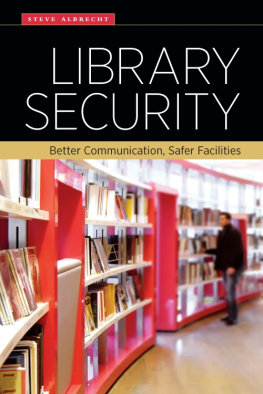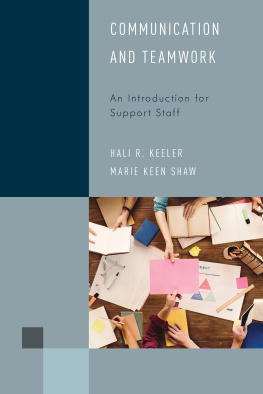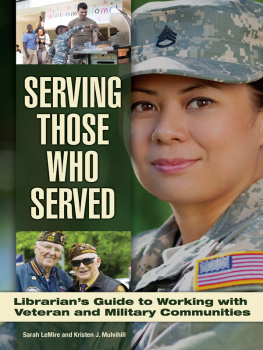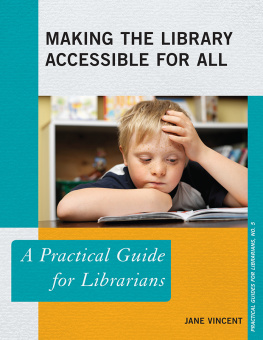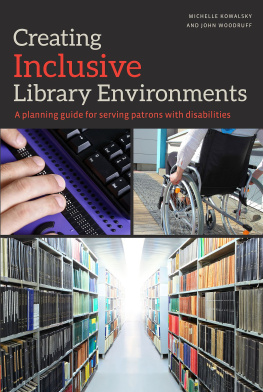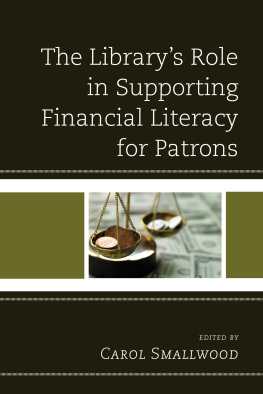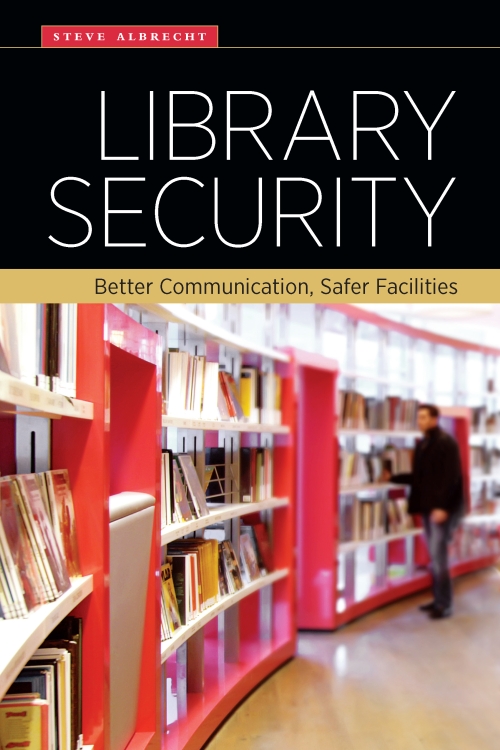
ALA Editions purchases fund advocacy, awareness, and accreditation programs for library professionals worldwide.
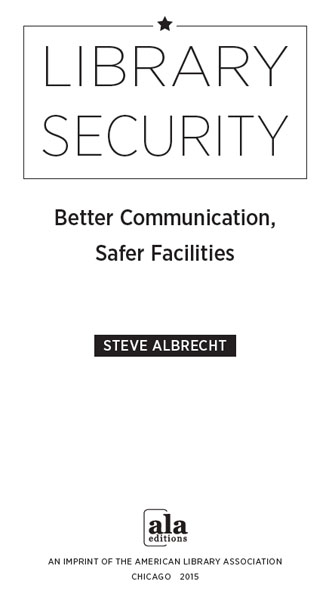
Dr. Steve Albrecht is internationally known for his work on workplace violence prevention. He is an experienced author, speaker, trainer, and consultant from San Diego, California. He manages a training and consulting firm specializing in high-risk human resources issues, organizational security concerns, and work culture improvement. His sixteen books include Tough Training Topics, Service! Service! Service!, Added Value Negotiating, Ticking Bombs: Defusing Violence in the Workplace (written in 1994 as one of the first books on this subject), and Fear and Violence on the Job. He is a retired San Diego Police reserve sergeant who holds a doctorate in business administration, an MA in security management, a BS in psychology, and a BA in English. He is board certified in human resources, security, and employee coaching.
2015 by the American Library Association
Extensive effort has gone into ensuring the reliability of the information in this book; however, the publisher makes no warranty, express or implied, with respect to the material contained herein.
ISBNs
978-0-8389-1330-7 (paper)
978-0-8389-1354-3 (PDF)
978-0-8389-1355-0 (ePub)
978-0-8389-1356-7 (Kindle)
Library of Congress Cataloging-in-Publication Data
Albrecht, Steve, 1963
Library security : better communication, safer facilities / Steve Albrecht.
pages cm
Includes .
ISBN 978-0-8389-1330-7 (print : alk. paper) 1. LibrariesSecurity measures. 2. Library buildingsSafety measures. I. Title.
Z679.6A43 2015
025.82dc23
2015005575
Cover design by Alejandra Diaz. Imagery Shutterstock, Inc.
To my parents, Eileen Hodes and Karl Albrecht
CONTENTS
I like libraries now and I loved them as a kid. And Im a book guy; reading and writing (sixteen books so far) have been important parts of my entire life. I was also a cop, and for the past fifteen years, I have taught a program called The Challenging Patron for dozens of libraries. If youre like me, you may have thought library work was about books and research and study and information management. I quickly learned that its really about people. And on some days, it can be about eccentric, idiosyncratic, needy, odd, charming, or kindas well as challengingpeople.
Looking back on a career that includes law enforcement, human resources, security consulting, writing, seminar training, and university classroom teaching, I have found my work in threat assessment to be the most useful for libraries. In 1994, I coauthored the book Ticking Bombs: Defusing Violence in the Workplace (Irwin), which was one of the first titles on that subject. Ever since, I have devoted much of my thinking and actions to keeping people safe at work. Despite the books national attentioneven an Oprah appearance for my coauthormy pitch for training services was usually declined. Workplace violence was connected to a theme that still exists today: The phenomenon of armed and angry people coming into offices, factories, malls, churches, restaurants, movie theaters, and government agencies. Statistics bear out that the now-familiar active shooter (an odd term of art used mostly by law enforcement and taught to our culture by the news media) still is rare enough to be an anomaly, not something for a business owner or manager to worry about. In April 1999, however, a toggle switch for our national consciousness was thrown at a high school in Jefferson County, Colorado. The school shootings at Columbine High School changed the game for all of us: Cops, security practitioners, human resources (HR) administrators, school district officials, and business owners and operators. Soon after, people were calling me and my early arriving colleagues with requests for training and site security assessments of their facilities or to assess the risk posed by a bitter, terminated employee, an employees domestic violence situation, a troubled student on a K12 or college campus, or a threatening taxpayer, visitor, vendor, or customer. Conversations with HR directors and managers in public-sector city and county agencies often included concerns about the library. I was surprised. What could possibly go on at the library? Isnt it a place for people to read books and magazines? Whos bothering people at the library?
In 2000, Cheryl Gould and the folks at Infopeople in California asked me to design a program to help library staff members deal with challenging patrons. I soon found myself standing in front of the staffs of public libraries, law libraries, and university libraries in big and small cities, urban environments, and rural locales. Even as a child, I knew the library drew some odd people, and I stayed away from them in the stacks. As a patrol officer with the San Diego Police Department, I had escorted from the library a few obnoxious street people and several dozen drug and alcohol enthusiasts, and I had written up a few theft reports for personal property, books, or videos. Only when I started presenting library workshops, however, did I begin to see the rest of the iceberg.
Some libraries seem to attract the poor and the bewildered, the opportunistic crook and the sneak thief, gang members, abandoned or runaway kids, people who cant control their Axis II disorders or maintain sobriety, the sexual predator who prefers children, or the pornography enthusiast who, for some unknown reason, doesnt have his own computer or access to the Internet. I was discouraged hearing one library worker after another tell me that he or she had been flashed by a guy in an overcoat or asked to help print out color photos of bestiality porn. Younger female staff members complained of being stalked by male library patrons who read their name tags or employee ID badges with their first and last names and job titles and used library computers to get personal information on them. Gang members came to the library to vandalize the building or tag the books with their graffiti, recruit other kids or shake them down for money, sell drugs, or steal purses, phones, and tablets. Teenagers have sex in the secluded areas. Neglectful parents drop off too-young kids for twelve hours. Alleged caregivers roll their wheelchair-bound or elderly patients to a table, give them a book, and then leave for ten hours. The homeless eat, sleep, and panhandle in the library and take sink showers in the restrooms. People bring into the branches comfort animals, not trained dogs for the blind or disabled, but snakes, ferrets, parrots, turtles, and rats. In the San Francisco Civic Center branch and the main downtown City of Los Angeles libraries, the uniformed security staff members post pictures in their guard offices of the worst offenders, thieves, and sexual predators.
I have heard your stories. The common thread is that these patrons and the situations they create make your working lives miserable, bother other library customers, and raise liability concerns.
Nevertheless, challenging people need your best efforts to serve their needs. This book will help you feel more comfortable around uncomfortable people. It discusses creative patron communication methods and what I define as high-risk customer service tools for behaviors that raise the stakes. In law enforcement, we used the Rule of Three to get compliance from uncooperative people: Ask. Tell. Make. You have the ability to use the first two. A challenging patrons interaction with you, another staff member, or another patron may become so problematic that you need to call the cops for the third. This book will help you decide if youve reached that point.

